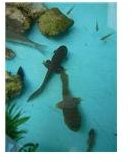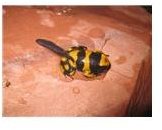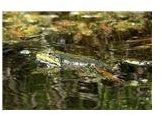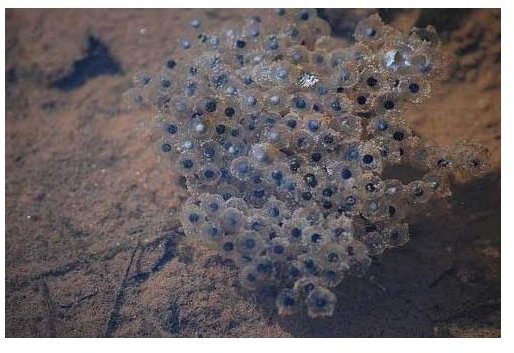All About Frogs: From Eggs to Tadpoles to Frogs
In the Beginning
Frogs are amphibians: cold blooded animals that are vertebrate, meaning they have a spine and have two phases in development. These stages typically begin with a water and gill breathing larval stage, which is followed by a land and lung breathing stage. The life cycle of a frog begins with spawning.
Spawning: A male and a female frog mate. During this process of spawning, the female frog begins laying eggs which the male fertilizes as they are coming out.
Fertilization: The process of releasing sperm onto the eggs which enable the eggs to develop into tadpoles is called fertilization. An egg that has not been fertilized will not begin the process of cell division that results in a tadpole.
Eggs: The fertilized egg is the beginning of the life cycle of a frog. The female frog will lay many eggs in a large clump called a clutch that is surrounded by a jellylike substance which may be attached to vegetation in the pond or may be free floating in the center of the pond. A toad will lay strands or lines of eggs. The eggs are laid in a large clutch to help keep them from being eaten by other pond life or birds.
The Tadpole
Tadpole also called a polliwog: The tadpole begins as a single cell organism inside the egg. It survives on the yolk inside the egg as

it grows. While in the egg, the cells begin to divide over and over until you have a small tadpole that will hatch out of the egg around six to 21 days after the egg was fertilized. A tadpole in essence is nothing more than a mouth, gills and a tail.
These tadpoles are quite small and attach themselves with a sticky substance on their bellies to plant life in the pond. They try to stay hidden from predators that may eat them. At this point, they will survive from the yolk that is left in their guts.
After about seven days, the hatched tadpole will start to swim and may eat plant life such as algae. It often swim in schools or in groups with other tadpoles. As the tadpoles get bigger, they will also eat small insects.
Around four weeks after hatching, the tadpole will begin to develop tiny teeth to help it grind its food and develops skin which will

cover over the gills. It then starts to breathe with its developing lungs. Tadpoles will dart to the surface of the water to take gulps of air.
Around six to nine weeks, the tadpole will become longer and will start to develop a head and the legs of a frog. These legs start out as bulges in the front and back of the tadpole. The tail shortens more and more as the tadpole develops.
The Frog
<strong>Froglet:</strong> Between nine and 12 weeks after hatching, the tadpole has lost most of its tail and has developed a tongue with which the

frog
will use to eat insects! The tadpole is now almost a full grown frog and will spend time out of the water.
Frog: When the frog is around 12 to 16 weeks, you will now see a fully metamorphosed frog.
Metamorphosis is the process of changing from a tadpole to a frog. Frogs live predominately on land and breathe air through lungs. However, many frogs still like to swim! Now the mature frog can mate and/or lay eggs and the process will begin again.
Creatures of Childhood
A lot of us had a familiarity of frogs growing up. They always seemed like wondrous creatures, and the subject of many childhood stories. I hope you have a new appreciation for this amazing amphibian!
References
Bookshelf: The Frog Life Cycle, www.ncbi.nlm.nih.gov/books/nbk10035

Life Cycle of a Frog Website: Frog Life Cycle, www.frog-life-cycle.com
Frogland, allaboutfrogs.org
Images:
Frog Eggs: Flickr Image by Just4u2009 under CC by 2.0
Polliwog on a Rock: Flickr Image by Ned Raggett under CC by -ND 2.0
Water Tank: Flickr Image by Matsuyuki under CC by -SA 2.0
Just Barely out of Water: Flickr Image by Erick Mattheis under CC by -SA 2.0
Frog in Pond: PublicDomainPictures.net Image by Vera Kratochvil under Public Domain
Frog: PublicDomainPictures.net Image by David Wagner under Public Domain
